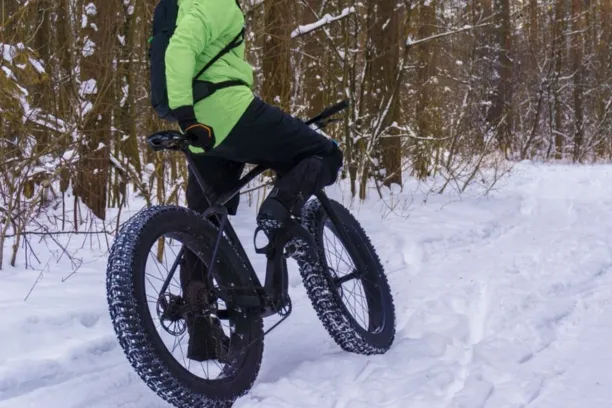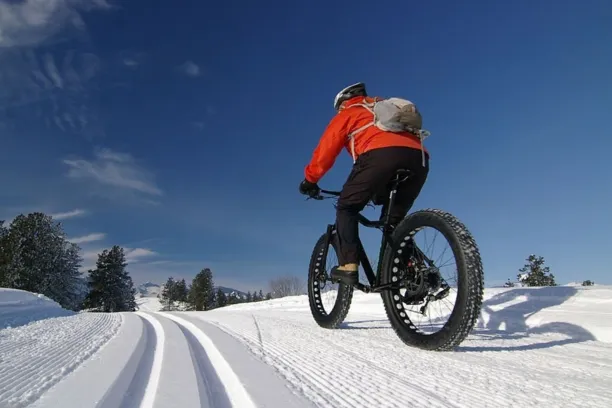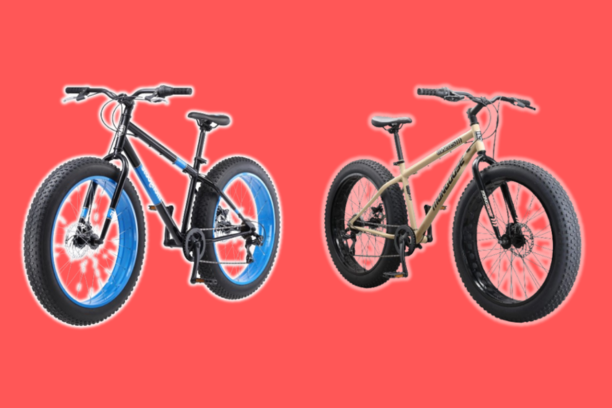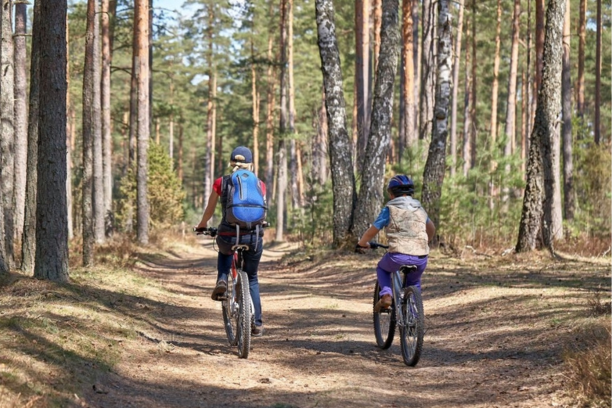What is a Fat Bike?
A fat bike, also known as an “all-terrain bike,” is a specially designed bicycle with oversized tires that provide exceptional traction and stability on various surfaces.
These bikes have gained immense popularity in recent years due to their ability to conquer challenging terrains like snow, sand, and rough trails. Let’s dive into the world of fat biking and explore its unique features!
Key Features of a Fat Bike
When it comes to fat bikes, their unique features set them apart from traditional bicycles. Let’s explore the key elements that make these all-terrain machines so exceptional.
Wide Tires: Enhancing Traction and Stability
Fat bikes are equipped with wide tires, typically ranging from 3.8 to 5 inches in width. These oversized tires play a crucial role in providing better traction and stability on various surfaces such as snow, sand, or rough terrains.
With increased tire surface area touching the ground, riders can confidently navigate through challenging conditions without losing control.
Frame Design: Accommodating Wider Tires for Optimal Performance
The frame design of fat bikes is specifically crafted to accommodate those wider tires comfortably.
The unique geometry allows sufficient clearance between the tire and frame, preventing any interference during rides.
This design feature ensures smooth maneuverability while maintaining stability even on uneven grounds or when cornering at high speeds.
Suspension Options: Choosing Between Rigid or Suspension Forks
Fat bike enthusiasts have two options when it comes to suspension systems – rigid forks or suspension forks.
Rigid forks lack shock absorption but offer simplicity and durability ideal for smoother terrains like packed trails or urban commuting.
On the other hand, suspension forks come with added comfort by absorbing bumps and vibrations encountered on more rugged off-road adventures; however, they may add weight and require maintenance.
Drivetrain Compatibility: Tailoring Gearing System for Different Needs
Fat bikes support various drivetrain components suitable for different riding preferences.
Riders can choose among single-speed setups for simplicity and low maintenance requirements; 1x drivetrains offering a wide range of gears without front derailleur complications; or multi-gear configurations suitable for tackling steep hills and varied terrain conditions.
Braking System: Optimal Stopping Power with Disc Brakes
Disc brakes are considered the standard choice in fat bikes due to their superior stopping power.
These brakes ensure reliable and consistent performance, even in wet or muddy conditions. With the ability to modulate braking force effectively, riders can confidently navigate downhill sections or make sudden stops when needed.
Advantages and Applications

Fat bikes are not just ordinary bicycles; they excel in various conditions and offer unique advantages that cater to specific riding needs.
Riding on Snowy Terrain
When it comes to snowy conditions, fat bikes are unmatched. With their wider tires, these bikes provide enhanced floatation over snow-covered surfaces.
The increased surface area allows riders to effortlessly glide through deep snow, opening up thrilling opportunities for winter adventures.
Beach and Sand Riding
Ever dreamt of riding a bike along sandy beaches? Fat bikes make this dream a reality! Their oversized tires maintain stability on loose sand by distributing weight more effectively.
Whether you’re cruising along the shoreline or exploring dunes, fat bikes deliver an exhilarating experience like no other.
Mountain Biking Adventures
While traditionally associated with winter terrains, fat bikes have found their way into mountain biking trails as well. Some mountain bikers embrace these all-terrain beasts for their ability to handle challenging off-road trails throughout the year.
The wider tires provide exceptional traction, allowing riders to conquer rugged terrains confidently.
Touring and Bikepacking Possibilities
Fat bikes are ideal companions for long-distance touring trips or bike-packing adventures. Thanks to their durability and ability to tackle diverse terrains, these versatile bicycles can carry heavy loads while maintaining stability during extended journeys.
Urban Commuting
Not limited to off-road adventures alone, fat bikes also bring benefits when it comes to urban commuting. The large volume of the tires helps absorb road vibrations, providing a more comfortable ride on city streets. Additionally, the enhanced stability and traction ensure confident maneuvering through traffic or rough pavement.
Health Benefits & Fitness Aspects
Riding a fat bike offers more than just outdoor adventures; it’s also an excellent way to stay active and fit. The nature of fat biking engages various muscle groups, providing a full-body workout while burning calories.
Selecting Your Ideal Fat Bike
Choosing the right fat bike is essential to ensure an enjoyable riding experience that meets your specific needs and preferences. Let’s explore the key factors to consider when selecting your ideal fat bike.
Determine your needs & goals before buying
Before making a purchase, take a moment to assess your riding needs and goals. Are you planning on tackling snowy terrains or embarking on long-distance touring trips?
Understanding what you expect from your fat bike will help narrow down options and make an informed decision.
Frame Material Choice
Fat bikes are available in various frame materials, each offering unique characteristics. Aluminum frames are lightweight and cost-effective, while carbon fiber frames provide superior strength with reduced weight.
Steel frames offer durability and smooth ride quality but can be heavier compared to other materials.
Tire Selection
Consider the terrain you’ll mostly be riding on when choosing tires for your fat bike. If you’ll primarily ride in snow or soft conditions, wider tires with aggressive tread patterns are recommended for optimal traction.
For mixed-terrain use or more packed trails, slightly narrower tires with less aggressive treads may suffice.
Suspension Preferences
Decide whether you prefer a rigid or suspension fork setup based on the type of terrain you’ll encounter most frequently during rides.
Rigid forks offer simplicity, low maintenance requirements, and better efficiency on smoother surfaces like roads or groomed trails; whereas suspension forks absorb impacts for increased comfort when navigating rougher terrains.
Budget Considerations
Set a budget range that aligns with the features and components you desire in a fat bike without compromising quality or safety standards.
Remember that investing in higher-quality components often results in improved performance and longevity of the bicycle.
Care and Maintenance Tips
To keep your fat bike in optimal condition and ensure a smooth riding experience, proper care, and maintenance are crucial. Let’s explore some essential tips to help you maintain your fat bike.
Cleaning & Lubrication: Keeping Your Bike Sparkling
Regular cleaning is essential to remove dirt, mud, and debris that can accumulate on your fat bike after rides.
Use a mild soap or bike-specific cleaner along with a soft brush or sponge to gently clean the frame, tires, and drivetrain components. After cleaning, make sure to dry the bike thoroughly to prevent rust.
Lubrication is equally important for maintaining smooth functionality. Apply lubricant specifically designed for bicycles on the chain, derailleurs, and other moving parts regularly. Remember to wipe off any excess lubricant as it can attract more dirt.
Proper Tire Inflation: Maintaining Optimal Performance
Maintaining proper tire inflation ensures optimal performance while preventing damage or premature wear.
Inflate your fat bike tires according to the manufacturer’s recommended pressure range indicated on the sidewall of each tire. Use a reliable gauge pump for accurate measurements.
Storage Guidelines: Protecting Your Fat Bike
When not in use, store your fat bike in a cool and dry place away from direct sunlight or extreme temperatures that could affect its components negatively.
Consider hanging or using a dedicated bicycle stand if possible to avoid placing unnecessary weight on tires or other parts.
If storing for an extended period, give extra attention by applying grease on exposed metal surfaces such as bolts and screws to prevent corrosion. Additionally, periodically check tire pressure during storage months as air loss may occur over time.
Frequently Asked Questions
Are fat bikes only suitable for snowy conditions?
No, fat bikes are not limited to snowy conditions alone. While they excel in snowy terrain due to their enhanced flotation capabilities, they are also versatile enough for other surfaces like sandy beaches or off-road trails with loose soil.
Can I ride a fat bike on regular paved roads?
Yes! Although primarily designed for off-road adventures, fat bikes can be ridden on regular paved roads as well.
Do I need any specialized gear or equipment for riding a fat bike?
While not necessary, there are some specialized accessories that can enhance your fat biking experience.
Are there different sizes available for fat bikes?
Yes! Like other bicycles, fat bikes come in various frame sizes to accommodate riders of different heights and proportions. Choosing the right size ensures optimal comfort and control while riding.
Conclusion
Fat bikes are not your average bicycle. With their wide tires, unique frame design, and versatile capabilities, they excel in various terrains and offer unmatched riding experiences.
Whether you’re conquering snowy landscapes, exploring sandy beaches, or tackling off-road trails, fat bikes provide enhanced traction and stability.
Additionally, their applications extend to touring trips, urban commuting convenience, and even fitness benefits. Embrace the excitement of fat biking and unlock a world of extraordinary adventures on two wheels!






